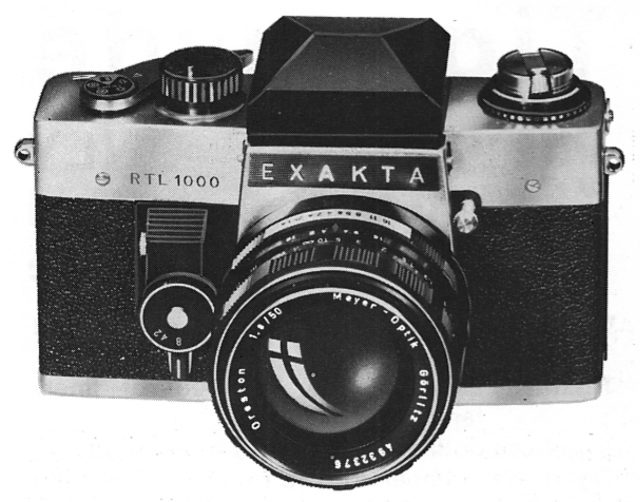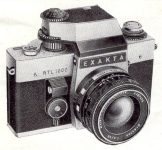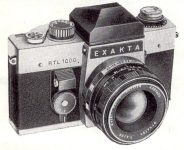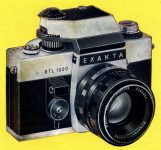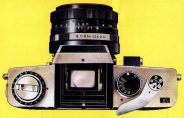Announced
Production status
System
Exakta RTL 1000
35mm MF film SLR camera • Discontinued
Specification
| Format: | |
| 35mm full frame | |
Film type: | 135 cartridge-loaded film |
| Exakta [44.7mm] | |
| Shutter: | |
Type: | Focal-plane |
Model: | Mechanical |
Speeds: | 8 - 1/1000 + B |
| Exposure: | |
Exposure metering: | None |
Exposure modes: | Manual |
| Physical characteristics: | |
Weight: | 645g |
Dimensions: | 142x96x49mm |
Manufacturer description #1
34 years after inventing the World's First 35mm SLR Exakta proudly announces
The Rebirth of the S.L.R.
RTL 1000 by Exakta
Radically new. Truly modern. Sleek, streamlined. The feel of lightweight efficiency. Embodies new creative capabilities. Yet retains the classic Exakta quality. Unmatched features that endured through the years. Like the exceptional range of shutter speeds (from 8 sec. to 1/1000 sec.), slow speeds, delayed action selftimer. Or the unbelievable choice of interchangeable finders, focusing screens and accessories. The incredible selection of lenses...
World's Most Versatile Camera.
The RTL 1000 features an interchangeable TTL meter COUPLED to shutter speeds. Measures entire focusing screen at shooting aperture. An ingenuous auto diaphragm mechanism, so you can use all new "internal release" automatic lenses. And all the older "external release" automatics. You get right hand and left hand shutter releases. A superb 50mm F1.8 Meyer Oreston lens. Many other technical refinements, too numerous to list.
The RTL 1000 - magnificent precision, rugged dependability! Perfect system for the advanced amateur and the pro, for the scientist, the physician. Solves the most challenging problems. And you'd expect to spend much more, yet the RTL retails for under $250.00.
Manufacturer description #2
The EXAKTA RTL 1000, maintaining the use of the world-renowned quick-change bayonet and offering plenty of valuable innovations to up-to-date miniature photography, continues the great traditions of this high-performance camera. These innovations are based on the well-approved principle of the true single-lens reflex camera with its always parallax-free correspondence of reflex image and photograph. These are the most important features of your EXAKTA RTL 1000:
SimpIe arrangement of all operating controls. Interchangeable viewfinder systems: Finder Hood, Penta Prism, and TTL Penta Prism for the automatic exposure timing with internal measurement, the lens being stopped down or fully opened. Focal-plane shutter made of metal laminae and destined for the complete series of shutter speeds from 8 seconds to 1/1000 second, 1 second to 1/1000 second with built-in delayed-action release. B setting for any long shutter speeds. Right-hand and left-hand release. Quick tensioning with a 30° preliminary elevation for series of photographs. Instant return mirror. Synchronising switch for electronic flash units and flashbulbs: electronic flash units being synchronized with approximately 1/125 second, fast-burning flashbulbs with 1/30 second. Automatic film loading system with free selection of film. Frame counter automatically returning to its initial position. Rewind release catching in. Interchangeable lenses with original EXAKTA quickchange bayonet and automatic diaphragm mechanism with internal release. On the left-hand release there can be employed any earlier EXAKTA lenses with automatic diaphragm mechanism. Accessories for any field of application.
Manufacturer description #3
For more than three decades, the EXAKTA has been characterized as the prototype of the versatile 35 mm reflex camera, as the camera of the serious amateur, of the professional, of the scientist. The EXAKTA RTL 1000, too, is marked by these qualities. Its range of applicablity is even wider still, owing to notable innovations in design and a greater variety of accessories offered for selection. However - and now comes the decisive factor in this altogether newly developed reflex camera - considering all its versatility it is, far more than its predecessors, the camera for everyone, extremely reliable, and simple to operate. With automatic exposure control, automatic film loading, the newly designed automatic diaphragm, and other refinements for action shooting, it is fashioned for the photographer of our time. The EXAKTA RTL 1000 meets his exacting demands, it helps him to avoid making mistakes in operation, yet it requires but a minimum of attention. As a genuine EXAKTA it has, of course, remained true to its system: The unchanged, original quick-change bayonet fitting permits using the well-known accessories and all the previous lens models, and single-lens reflex focusing ensures at all times parallax-free conformity of finder image and final picture.
The most significant features of the EXAKTA RTL 1000 are:
- Genuine single-lens reflex camera 24 x 36 mm.
- Three interchangeable viewfinders: Finder hood, prism viewfinder, and TTL prism attachment coupled to speed-setting knob for automatic exposure control, permitting internal metering with the lens stopped down or at full aperture.
- Metal-bladed focal-plane shutter for a continuous range of speeds from 8 secs. to 1/1000 sec. and B. Self-timer from 1 sec. to 1/1000 sec.
- Rapid wind lever with 15 degree advance stroke for serial shots. Right-hand release. Connecting point on left side of camera for lenses with automatic diaphragm and external release, connection for cable release. Instant return mirror.
- Synchronization for flash exposures: electronic flash at approximately 1/125 sec., bulbs for short flash duration at 1/30 sec.
- Accessory shoe for flash units with direct contact.
- Automatic film loading system with free selection of fiIm. Self-zeroing frame counter. Click-in rewind release knob. Rewind crank.
- Interchangeable lenses with original EXAKTA quick-change bayonet mount and internally operating automatic, also disconnectable, pressure diaphragm which, by means of a control mechanism in the EXAKTA RTL 1000, is converted into the higher grade automatic spring diaphragm.
- Automatic diaphragm of previous EXAKTA lenses may be used.
- Special-purpose lenses with focal lengths from 20 mm to 1000 mm.
TTL metering always gives correct exposure results
The highly developed EXAKTA RTL 1000 guides you into photographic territories that you have perhaps never entered before. But how reassuring it is to know that you will always get correctly exposed pictures if you take advantage of the automatic exposure control system in this way: Direct the EXAKTA RTL 1000, equipped with the coupled TTL prism attachment, towards your subject, rotate either the diaphragm setting ring of the camera or the speed setting dial of the TTL prism attachment until the meter needle visible in the viewfinder image centres on the index circle, then actuate the shutter release. Extremely simple, and yet absolutely reliable, since the TTL prism attachment works in accordance with the principle of internal metering through the lens. Only the light used in composing the picture is measured. The resulting values are accurate, even in connection with special-purpose lenses (image angle = metering angle), and with extension equipment and filters (automatic compensation for exposure factors). Beside the luminous density of the subject, film speed and pre-set diaphragm, or shutter speed, are, of course, taken into account. You may take the reading with the lens closed down or at full aperture.
Technical features of the TTL Prism Attach ment: Integrating system of ligth metering. Thus ensuring correct valuation of subject brightness. No decrease in brightness of finder image. Sensitivity range comprises 13 exposure values. Luminous density measurable from 4 apostilbs at f/2 up to the highest values. Bridge circuit guards against effects caused by voltage fluctuation. Mercury oxide battery (Mallory PX 13 or similar type with 1.35 V nominal Voltage).
Three viewfinder systems ensure maximum image sharpness
The extreme adaptability of the EXAKTA RTL 1000 results from the possibility of exchanging the finder systems. For modern, expressive photography, you will certainly prefer using the prism viewfinder or, better still, the TTL prism attachment, both revealing an upright, laterally correct finder image. However, when working with tripod, copying stand, microscope, or similar means of fixing the camera, in exposing below or above eye level, also in candid photography, you will appreciate the remarkable qualities of the finder hood. The viewfinders can be exchanged in an instant. Normally, you will use each one of the viewfinders with the approved focusing system - a brilliant Fresnel lens with microprism screen and groundglass circle -. You will be delighted, when viewing and selecting your picture area, to observe the bright, powerfully magnified finder image. But to achieve utmost definition, you have, above all, the groundglass field, and the microprism screen with its striking effects of unsharpness and fuzziness. The focusing system itself is interchangeable, too, so that, for instance in extreme close-up work or in photomicrography, special focusing screens may be inserted. These are available in clear glass with hairline cross, with clear centre spot and hairline cross, or with auxiliary lines, thus greatly facilitating accurate composition in specialized fields of photography.
Shutter speed settings from 1/1000 sec. to 8 sec.
At either one of these speeds, even allowing for extreme demands, approximately 98 % of your pictures will be correctly exposed. This figure includes every subject from the exciting sports shot up to night and indoor exposures. And for the last 2 %, the longer time exposures, you employ the B setting of your EXAKTA RTL 1000. You have at your disposal the newly developed, vertically running metal-bladed focal-plane shutter. Its outstanding feature is extreme dependability, while it is perfectly easy and ready to operate. The most frequently used shutter speeds, from 1/1000 sec. to 1 sec. are continuously arranged around a setting dial with click stops. An extra slow-speed mechanism makes it possible, in unfavourable lighting conditions, to work at settings of 2 sec., 4 sec., or 8 sec.
The shutter release is on the right-hand side of the camera in convenient finger-tip position and can be locked against inadvertent tripping. A cable-release connection is on the left-hand side of the camera. Also, the EXAKTA RTL 1000 has a built-in self-timer with a release knob of its own: Everyone of the shutter speeds from 1/1000 sec. to 1 sec. may be used with the delayed-action device running for about 10 secs.
The shutter is immediately recocked by means of the rapid wind lever. For ultra rapid sequence in serial shots, you will save time by setting the cocking lever to a 15° advance stroke. Owing to the instant return mirror in the EXAKTA RTL 1000, the viewfinder image is continuously visible except for the moment of the exposure. Having released your shutter, you can immediately check the effect of your exposure and decide if it seems advisable to take a second shot. A signal in the viewfinder image reminds you if the shutter has to be cocked.
Synchronization of electronic flash at 1/125 sec.
In the EXAKTA RTL 1000, the shutter speed to be set for the use of electronic flash units is 1/125 sec. The applicability of this most important light source has thus been increased to a very great extent. Blurred double images, due to motion, will no longer appear, even under relatively bright general lighting conditions, and flash can be used in addition to daylight more frequently. - Owing to the high speed of the shutter blades the EXAKTA RTL 1000 has been equipped with only one synchro switch.
Thus, there is only one flash socket, and the necessary adjustment of the shutter speed setting knob is made according to two symbols. Electronic flash, as already mentioned, at approximately 1/125sec. (symbol ↯), bulbs for short flash duration 1/30 sec. (symbol BULB). The flash units can be attached directly to the camera by means of an accessory shoe also equipped to accept the centre contact.
Film loading presents no problem whatever
The comprehensive assortment of 35 mm film in standard commercial cartridges may be used unrestrictedly in the EXAKTA RTL 1000. The decisive factor, however, is that all these films provide the conveniences of automatic film loading. All that is left for the camera user to do, is quick and easy work: Opening the camera back (simple unlocking device), inserting the cartridge, moving the film across to the marking point and under the supporting plate, closing the camera back, cocking the shutter and releasing it until the exposure counter, which jumps to zero when the camera back is opened, stands on "1". Thus, the EXAKTA RTL 1000 is ready for action. When the whole of your film is exposed, you just depress the rewind release, which clicks in, and wind the film back into the cartridge by means of the sturdy rewind crank. That is really all that camera and film require of you. Film type indicator and film speed indicator may be set to remind you which negative material you have loaded.
Please note the handsome, convenient styling of the small light-metal body, also the neatly designed, simple arrangement of all control parts. This is a camera that you can be proud of!
Every refinement in optical equipement
A high-class camera, high-class lenses - how could it be otherwise? That is why none but carefully selected, branded lenses are offered to go with the EXAKTA RTL 1000. They are exchangeable in an instant, and meet every requirement, optically and mechanically. Their highly valued qualities will mean much to you in practical work, so, for instance, utmost definition and good contrast effect, colour fidelity, helical focusing, depth-of-field scale, the original EXAKTA quick-change bayonet mount, and automatic diaphragm control. Especially worth mentioning is the fact that the EXAKTA RTL 1000 utilizes newly developed lens models with internally operating automatic, but also disconnectable, pressure diaphragm which, by means of a control mechanism in the camera, is converted into the higher grade spring diaphragm. This makes picture taking far simpler and more accurate. The range of hitherto familiar EXAKTA lense is, of course, still applicable. With the aid of an extension piece, the automatic diaphragm with external release mechanism can be actuated without limitation from the coupling point on the left-hand side of the camera. Special-purpose lenses with focal lenghts from 20 mm to 1000 mm are available, up to 300 mm with automatic diaphragm. Extreme telephoto objectives may be fitted to the outer bayonet rim of the EXAKTA RTL 1000 and they give full coverage of the image field without any vignetting effect.
From the Modern Photography magazine (December 1970)
The 1000RTL is a brand-new camera design which uses the Exakta bayonet mount and accepts all old interior bayonet, automatic diaphragm or manual Exakta lenses. Aside from the mount, no part of it has any resemblance to the old trapezoidal 1936 design. The automatic diaphragm mechanism for the new lenses is internal, it has a right-hand operating rapid-wind lever, right-hand shutter release (with additional left-hand release), an interchangeable behind-lens meter prism which is semicoupled to the shutter-speed dial, measuring the entire focusing screen.
By twirling, aligning, and pressing tiny odd controls on the prism housing you can set the shutter speed yourself, line up the meter needle in the finder at full aperture, determine the right opening from the meter dial and then set the aperture on the camera lens itself. If this seems awkward, you can twist a few more odd controls and make readings at actual shooting aperture, but unlike all other SLR's using such as system, there is no convenient lever which stays in place and no large button to press. You have to set the camera lens on manual control with a little turn lever on the lens mount or push in on a small integral depth-of-field preview lever for which you must fumble while camera is at eye level.
The new metal shutter sounds like a Copal, syncs electronic flash like a Copal at 1/125 sec. and has the excellent accuracy of the Copal.
While there are no 26 speeds to 12 sec. as per the old Exaktas, there are the usual 1 to 1/1000 sec. set conveniently by a dial atop the camera and additional speeds of 2, 4 and 8 sec. built into a separate self-timer.
Although the metering system is awkward and clumsy (but there!), all isn't tears and wringing of hands. The camera is nicely shaped with a slightly bowed front, a very excellent large front shutter release lever, a good quick loading system which seems to be the one all East German cameras will adopt. The central microprism is a very good one, the surrounding fine-focusing collar excellent and the whole finder reasonably bright. The meter reads down to 1/8 sec. at maximum aperture with an ASA 400 film.
The 50mm f/1.8 Oreston is a very good one. It's nicely mounted, well finished, with very good, clear controls and it focuses down to 14 in. All the other Exakta lenses are available and if you can stand that external automatic diaphragm arm, you can get by O.K.
From the editor
The following "internal release" automatic lenses were produced for the Exakta RTL 1000:
- Meyer-Optik Gorlitz Orestegon 29/2.8 (later renamed to Pentacon 29/2.8 auto)
- Meyer-Optik Gorlitz Domiplan 50/2.8
- Meyer-Optik Gorlitz Oreston 50/1.8 (later renamed to Pentacon 50/1.8 auto)
- Carl Zeiss Jena DDR Pancolar 50/1.8
- Meyer-Optik Gorlitz Orestor 100/2.8 (later renamed to Pentacon 100/2.8 auto)
***
The weight and dimensions are indicated for the camera body with the finder hood.
